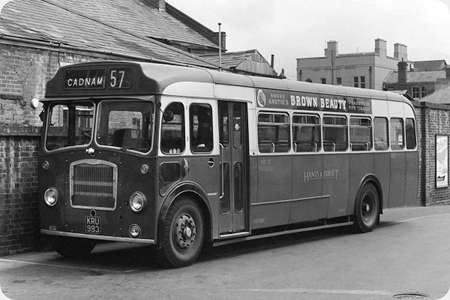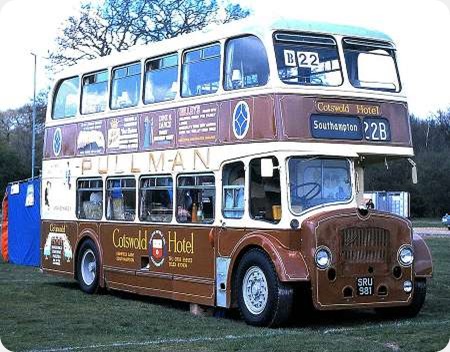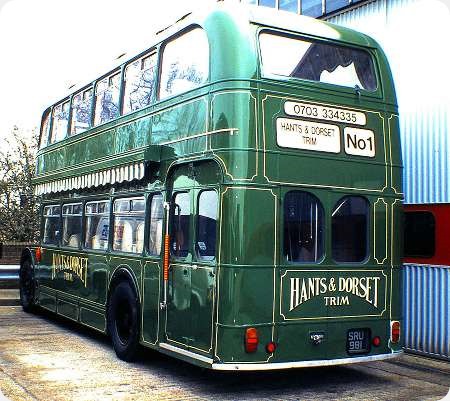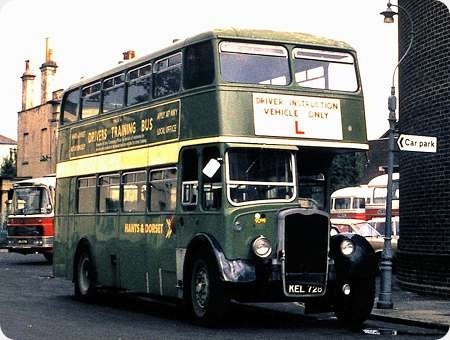
Hants & Dorset Motor Services
1951
Bristol KSW6B
ECW L27/28R
KEL 728 is a Bristol KSW6B new to Hants & Dorset in 1951. The ECW body was of the L55R variety when new. After withdrawal from passenger duty in 1969, it became one of the driver training fleet, with various alterations including the fitting of a sliding door and the replacement of most seats by concrete blocks. This was to simulate ‘loaded’ condition. We see it still in Tilling green and cream but with NBC fleetname in Grosvenor Square during the lunch break one day in August 1975.
Photograph and Copy contributed by Pete Davies
24/05/16 – 07:05
Grosvenor Square where, Pete?
Chris Hebbron
24/05/16 – 09:01
Southampton!
Shame cant see the registration of the coach behind. Wondered if it was H and D or Shamrock and Rambler.
David Rawsthorn
25/05/16 – 06:18
It was one of the ORU …G group, so H&D, but don’t ask me which one of the three!
Pete Davies
26/05/16 – 18:40
Living in Southampton as a schoolboy in the fifties, the Bristol engined Ks were familiar and friendly vehicles in the area. The KSW like 1285 was one of my favourite marques. The extra width, the style and finish of the interior trim had an edge (in my view) over other contemporary buses and maintained a brighter environment when compared to its successor, the Lodekka.
This vehicle was the first of the lowbridge KSWs delivered to H & D and all fourteen were allocated for the bulk of their lives to Southampton or Fareham depots. In the final years most migrated to Bournemouth and Poole, where they still maintained an elegant presence in the ‘Pines Territory’. My final journey on this type was on 1294 in November 1970 on a service from Bournemouth to Wimborne. Happy days!
Peter Elliott
29/05/16 – 05:47
About 30 years ago a letter appeared in Buses Illustrated commiserating with the hapless drivers of Bristols and comparing their lot with that of those lucky folk who drove London buses. The writer suggested that you don’t so much drive a Bristol as wrestle with it and finish your shift in utter exhaustion.
Well, he can never have driven a KSW, which has light, positive, bullet-straight steering, a light clutch, good progressive brakes, a gearbox less forgiving than some but still easy to get used to, a roomy cab with a good step and a firm handle to pull yourself up with, good visibility, reasonable level of engine noise, good stability… There must be something I’ve forgotten…
As a teenage enthusiast I found the ubiquitous KSWs and LDs uninteresting but a short spell of driving for Thames Valley in 1968 taught me what superbly designed vehicles they were.
What an indignity for KEL 728, having to carry concrete blocks around!
Ian Thompson
30/05/16 – 05:48
For my last 12 weeks RAF National Service (Jan-Mar 1959), I was posted to RAF Calshot, my mother living in Southsea. On Mondays, I’d take a trolleybus to Hilsea, a Southdown 45A which terminated at Fareham Bus Station, then the 77 H&D Bristol to Warsash service, then getting an air-sea rescue launch over Southampton Water to Calshot. The Bristol would have been in the yard all night and freezing cold, with frost inside the front windows needing to be scraped off! Arrival at our Calshot office necessitated laying the free-standing coke stove and getting it going before work started. It was noon before I’d really warmed up! The return journey on Fridays usually involved the Southdown 45 route which went all the way from Warsash to Southsea. So Fareham to Warsash was a shared route, with Southdown at its Westerly extremity at Warsash and Fareham being H&D’s Easterly extremity. Southdown usually put on PD2’s or Guy Arabs, but I seem to recall one Queen Mary, overkill for the route. But H&D had these KSW’s usually, which seemed quite civilised as I recall. It’s fair to say that these dozen trips on a Bristol bus constitute about a quarter of all rides I’ve ever taken on a Bristol in normal service!
Chris Hebbron
30/05/16 – 16:53
Fareham was not quite the easterly extremity of Hants & Dorset, Chris. During the three years I spent at Alverstoke (1949-52) my mother and I sometimes used to catch the Hants & Dorset service from Gosport (marginally farther east) to Lee-on-Solent or Tichfield and Southampton. The buses were Bristol K types back then, of course, probably K5Gs.
Roger Cox
30/05/16 – 16:54
As a very happy conductor and driver with Samuel Ledgard at Otley and Ilkley depots I regularly regretted that I would never drive a Bristol vehicle. However one morning I had to pinch myself as I reported to the garage to operate the 0807 duplicate from Otley to Leeds and back. Parked near the bus station with "Harrogate via Otley" on the destination blind was K6B KHY 746 (ex Bristol) – yes, it had suffered a front wheel puncture a few minutes earlier and had been replaced by one of our Otley vehicles. With fingers crossed I approached the output man for my bus to be told "You’ll have to take that 746 outside." Well, what an utter delight the vehicle was in every way – the gears were like silk, the brakes smooth and superb, visibility great, and the Bristol AVW engine enabled it to ascend the two mile long A660 in fine style. When we got to Leeds the disgruntled and totally disinterested young conductor came to the cab and said "I don’t know what you’re getting excited about, its only a b***** bus."
So naturally I fully agree with everything that Ian Thompson says in favour of the model even though "mine" was slightly earlier and "thinner" – the pedigree was the same !!
Chris Youhill
31/05/16 – 06:24
Geography and popular opinions of places’ locations do contradict each other sometimes. Chris Hebbron comments on his trips to RAF Calshot. One might think that, being on the western side of Southampton Water, it is west of Southampton. Certainly, buses head westwards out of Southampton towards Totton, Marchwood, Hythe, Fawley and Calshot, but Calshot Castle is actually due south of the mouth of the Hamble, east of Southampton. Roger Cox mentions his time at Alverstoke which, although many of the present residents refuse to acknowledge it, is actually in Gosport and east of Fareham. A strange situation applies at Fareham, which used to have two signal boxes. ‘East box’, being nearer to Waterloo on the original line through Basingstoke and Winchester, was actually WEST of ‘West box’ which was further away from Waterloo. I have some American Railroad DVDs in my collection, with maps. The commentary mentions ‘compass west’ which is the actual direction of travel, and ‘timetable west’ which is the nominal direction. What fun!
Pete Davies
31/05/16 – 06:24
One summer in the mid to late ‘sixties I remember my Dad, a West Yorkshire driver, saying that he had performed a duplicate on the 84 Harrogate-York-Scarborough service. His trusty steed was an ‘SBW’ (Bristol LWL6B/ECW B39R) and I’d assumed he would have been disappointed at the prospect of having to drive such an ‘old’ bus, heading up towards it’s retirement, over such a distance. (What shameful thoughts Brendan, even for a early teenager!). Well Dad said much the same as Ian and Chris (Y) have done and relished the experience. I recall him saying how light the steering and clutch were, and that the gearbox combined with the Bristol AVW engine worked a treat. All in all an enjoyable day out by the sound of it. Just wish I’d been along for the ride.
Brendan Smith
31/05/16 – 09:03
Brendan – I can well appreciate your Dad’s delight with the SBW. Although as an Ilkley depot conductor I never drove one I consider the SBWs to be the very finest examples of the wonderful ECW postwar "L" variants. Not only were they supremely handsome and "tidy", but within there could never have been anything finer – wide gangways, useful luggage racks, excellent stairs and sliding doors, good visibility, and easy passenger flow even with standing customers – that barmy over the top trendy term means passengers, customers patronise shops !! At Ilkley we had EB2/3 (31 seat luxury), SGL 14 (slim) and SBW 17/26/33.
Chris Youhill
01/06/16 – 06:53
Agreed Chris Y! A colleague used to define the difference this way (in connection with the railway industry): Passengers travel; Customers merely pay.
Stephen Ford
02/06/16 – 06:50
Chris and Stephen, bus drivers may be told by their employers to see passengers as ‘customers’ nowadays in order to promote real ‘customer service’. However, how many times do we see these same ‘customers’ treated with disdain, not by the drivers, but by the employers who cover the windows with Contravision, or vinyl promotional stickers and overlays, so that the allegedly all-important ‘customers’ cannot see out? ‘First still seems to be Worst’ in this regard, but sadly there are others out there. Thomas Tilling will be turning in his grave – if not already spinning like a starter motor.
Brendan Smith
04/06/16 – 06:46
Absolutely spot on Brendan. As is widely known, I ‘m in total despair these days at all the marketing, route branding, swooping "playschool" liveries etc – 99% plus of which goes right over the heads of the travelling public or simply understandably confuses them, and costs unimaginable amounts of money When will operators realise that all the Public want is a clean smart bus at the right time at a sensible fare.
Now, where did I put that tin helmet?? I’m sure I got it back from refurbishment not long ago !!
Chris Youhill
04/06/16 – 06:47
Thx, Roger, for making me aware of back-door H&D route to Gosport. I confess that on the few times I used to go over to Gosport, I never saw saw an H&D bus/bus stop to raise my curiosity!
Chris Hebbron
05/06/16 – 07:10
Hants & Dorset did have a presence in Gosport, though. On the occasions when I travelled across the water (or took the long way round via Fareham), there was often an H&D Bristol K lurking against a wall behind the Provincial line up at the bus stands. I don’t recall if it displayed any route number or destination, but my impression at the time was that it was parked up for later use. As the Provincial fleet had my stronger interest, I didn’t take so much notice of it! I don’t know whether when it came to service, it drew up on one of the Provincial stands, or whether it went somewhere else to begin it’s journey.
Michael Hampton
07/06/16 – 07:01
H&D ran several services to Gosport. The 70 and 93 ran from Southampton, each one hourly. The 70 was converted to OPO and became limited stop as X70 around the time the last REs (XLJ725/6K) were delivered. As far as I recall there were other local services, including an indirect service from Fareham.
Nigel Frampton
08/06/16 – 06:06
The construction for an embryonic new resort (intended to rival Bournemouth) given the supposedly prestigious name of Lee-on-the-Solent began in 1885 and proceeded apace. A pier was completed in 1888 and a light railway line (maximum permitted speed – 25 mph) was built in 1894 to connect with the Gosport/Stokes Bay main line at Fort Brockhurst on the western fringe of Gosport. In 1910 Provincial Tramways began operating connecting services with its tram operations from Bury Cross and Brockhurst into Lee, but these stopped during the First World War. (The railway services to Stokes Bay and the Isle of Wight also ceased in 1915, never to resume). The overambitious original scheme for Lee-on-the-Solent was never realised and public transport revenues on bus and rail services were poor. Provincial lost interest in Lee as a traffic objective and the railway, too, entered a period of terminal decline. It was Hants & Dorset who stepped in with viable bus links through Lee to Gosport and Southampton, and I understand that these still exist, though the vehicles when I last travelled on the route were attired in the absurd Barbie apparel.
Roger Cox
09/06/16 – 16:56
Hants & Dorset had an outstation at Gosport – in the early post-war period at Little Beach Road, and from the mid 1950s until early 1970s in Harbour Road (just off the A32 Mumby Road, north of the High Street), where there was a small waiting room as well as parking space. There were ‘local’ services to Hill Head, Lee-on-Solent, Heathfield and HMS Aerial, together with Gosport to Fareham via Rowner (79) and 3 routes from Gosport to Southampton 70 and 93 (both via Lee-on-Solent and Bursledon) and 76 (via Fareham and Botley). Hants and Doret had acquired the operations of independent, Tutt, in 1924 to which were others were – which formed the basis of the H&D services in the Gosport area.
Peter Delaney
18/06/16 – 06:08
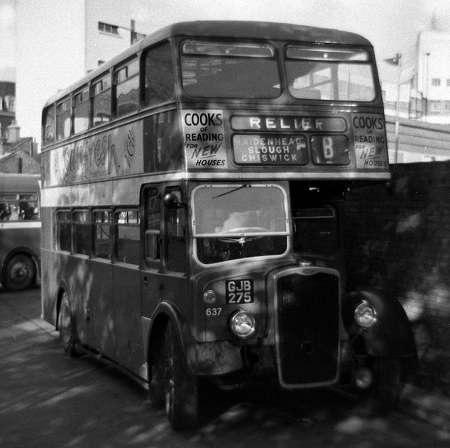
Here is a picture of another KSW6B of similar vintage to KEL 728, but operated by the neighbouring company of Thames Valley. GJB 275, fleet no. 637, was also a 1951 vehicle, but differed in being equipped with a “coach” CL27/26RD body with platform doors. Thames Valley had nine of these buses for the Reading-London service ‘B’, though, because the route was covered by Green Line 704 and 705 between London and Slough, pick up and set down restrictions applied over that section. All the early production KSWs had either the Gardner 5LW or the alternative Bristol AVW of 8.1 litres supposedly developing the magic figure of 100 bhp that was often optimistically claimed by manufacturers in the early post war period – Leyland, Crossley and Daimler were others, together with Dennis, though the Guildford claim was accurate. The AVW was a basically sound dry liner engine manufactured also in horizontal form, unlike the troublesome wet liner BVW 8.9 litre design that succeeded it. The KSW6G did not become available until 1952 with the ‘K’ version of the 6LW yielding a genuine 112 bhp. Were there initially some behind the scenes pressures on Tilling Group companies to accept the Bristol six cylinder engine to reduce production costs and free the manufacturer to some extent from the constraints of Gardner supplies? The Thames Valley “coach” KSWs ran on the ‘B’ service for many years, latterly as relief vehicles, and GJB 275 is pictured in Victoria Coach Station on such duties in the summer of 1960. One wonders how a lowbridge bus of this type would be received by the ‘discerning customers’ on such a lengthy route today, though I, for one, would jump at the opportunity.
Roger Cox
21/12/16 – 06:32
I remember taking a bus similar to this model from Romsey to Southampton on Route number 63. In the late 1960s, all the buses that ran to and from Romsey used to terminate or start their routes actually from Romsey Town Centre, this was before the Romsey bus station was even built, the sight formally having been occupied by the old Jam factory. I can remember that there were several routes operated by Hants and Dorset, and one of these was shared with Wilts and Dorset. Whilst single decker’s ran the routs 60 Braishfield to Southampton ( via Romsey, Ower, Totton, Millbrook. ) Route 66 Romsey to Winchester and then back and then ran Romsey to Salisbury via West Wellow, Shootash. This service was the shared route as you either got a Hants & Dorset or Wilts & Dorset bus in either direction. The 65 went to Eastleigh via North Badesley, and the original Castle Lane. The 65 was run by both single and double deck vehicles. The number 61, 62, 63 all ran Romsey to Southampton. One via Upton Crescent Rownhams and Nursling, Shirley and Southampton. 62 Romsey to North Baddesley Rownhams Lane, Horns Inn Nursling, Shirley, Southampton and the 63 Romsey North baddesley, Chilworth, Inner Avenue, thence into Southampton. The 64 route ran Shootash and also served a number of the local villages, this was always a single deck service. Hants and Dorset and Wilts and Dorset drivers were some real characters, very friendly and helpful. I remember two particular drivers who did long service on some of these routes. Geoff Whitfield being one of these people. There was also a older chap called Stan. Didn’t ever know his last name, and it wasn’t Butler! but he was a character that made travelling on these routes a pleasure, and a lot of fun. Pity we don’t have these routes now.
C. Phillips
